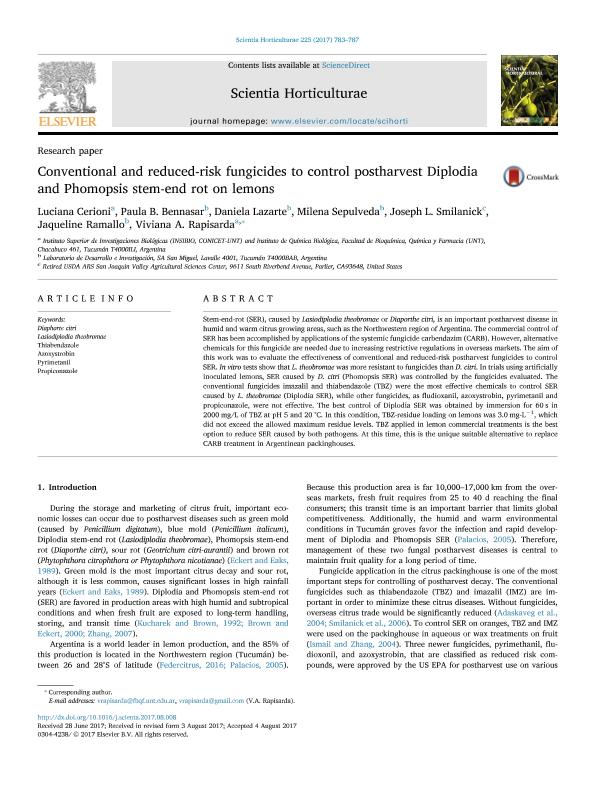Mostrar el registro sencillo del ítem
dc.contributor.author
Cerioni, Luciana

dc.contributor.author
Bennasar, Paula Bettina

dc.contributor.author
Lazarte, Daniela
dc.contributor.author
Sepulveda, Milena

dc.contributor.author
Smilanick, Joseph L.
dc.contributor.author
Ramallo, Jaqueline
dc.contributor.author
Rapisarda, Viviana Andrea

dc.date.available
2018-11-12T19:44:06Z
dc.date.issued
2017-11-18
dc.identifier.citation
Cerioni, Luciana; Bennasar, Paula Bettina; Lazarte, Daniela; Sepulveda, Milena; Smilanick, Joseph L.; et al.; Conventional and reduced-risk fungicides to control postharvest Diplodia and Phomopsis stem-end rot on lemons; Elsevier Science; Scientia Horticulturae; 225; 18-11-2017; 783-787
dc.identifier.issn
0304-4238
dc.identifier.uri
http://hdl.handle.net/11336/64283
dc.description.abstract
Stem-end-rot (SER), caused by Lasiodiplodia theobromae or Diaporthe citri, is an important postharvest disease in humid and warm citrus growing areas, such as the Northwestern region of Argentina. The commercial control of SER has been accomplished by applications of the systemic fungicide carbendazim (CARB). However, alternative chemicals for this fungicide are needed due to increasing restrictive regulations in overseas markets. The aim of this work was to evaluate the effectiveness of conventional and reduced-risk postharvest fungicides to control SER. In vitro tests show that L. theobromae was more resistant to fungicides than D. citri. In trials using artificially inoculated lemons, SER caused by D. citri (Phomopsis SER) was controlled by the fungicides evaluated. The conventional fungicides imazalil and thiabendazole (TBZ) were the most effective chemicals to control SER caused by L. theobromae (Diplodia SER), while other fungicides, as fludioxanil, azoxystrobin, pyrimetanil and propiconazole, were not effective. The best control of Diplodia SER was obtained by immersion for 60 s in 2000 mg/L of TBZ at pH 5 and 20 °C. In this condition, TBZ-residue loading on lemons was 3.0 mg-L−1, which did not exceed the allowed maximum residue levels. TBZ applied in lemon commercial treatments is the best option to reduce SER caused by both pathogens. At this time, this is the unique suitable alternative to replace CARB treatment in Argentinean packinghouses.
dc.format
application/pdf
dc.language.iso
eng
dc.publisher
Elsevier Science

dc.rights
info:eu-repo/semantics/openAccess
dc.rights.uri
https://creativecommons.org/licenses/by-nc-nd/2.5/ar/
dc.subject
Azoxystrobin
dc.subject
Diaphorte Citri
dc.subject
Lasiodiplodia Theobromae
dc.subject
Propiconazole
dc.subject
Pyrimetanil
dc.subject
Thiabendazole
dc.subject.classification
Agricultura

dc.subject.classification
Agricultura, Silvicultura y Pesca

dc.subject.classification
CIENCIAS AGRÍCOLAS

dc.title
Conventional and reduced-risk fungicides to control postharvest Diplodia and Phomopsis stem-end rot on lemons
dc.type
info:eu-repo/semantics/article
dc.type
info:ar-repo/semantics/artículo
dc.type
info:eu-repo/semantics/publishedVersion
dc.date.updated
2018-11-12T13:24:18Z
dc.journal.volume
225
dc.journal.pagination
783-787
dc.journal.pais
Países Bajos

dc.journal.ciudad
Amsterdam
dc.description.fil
Fil: Cerioni, Luciana. Consejo Nacional de Investigaciones Científicas y Técnicas. Centro Científico Tecnológico Conicet - Tucumán. Instituto Superior de Investigaciones Biológicas. Universidad Nacional de Tucumán. Instituto Superior de Investigaciones Biológicas; Argentina
dc.description.fil
Fil: Bennasar, Paula Bettina. SA San Miguel; Argentina
dc.description.fil
Fil: Lazarte, Daniela. SA San Miguel; Argentina
dc.description.fil
Fil: Sepulveda, Milena. SA San Miguel; Argentina
dc.description.fil
Fil: Smilanick, Joseph L.. No especifica;
dc.description.fil
Fil: Ramallo, Jaqueline. SA San Miguel; Argentina
dc.description.fil
Fil: Rapisarda, Viviana Andrea. Consejo Nacional de Investigaciones Científicas y Técnicas. Centro Científico Tecnológico Conicet - Tucumán. Instituto Superior de Investigaciones Biológicas. Universidad Nacional de Tucumán. Instituto Superior de Investigaciones Biológicas; Argentina
dc.journal.title
Scientia Horticulturae

dc.relation.alternativeid
info:eu-repo/semantics/altIdentifier/url/https://www.sciencedirect.com/science/article/pii/S0304423817304867
dc.relation.alternativeid
info:eu-repo/semantics/altIdentifier/doi/http://dx.doi.org/10.1016/j.scienta.2017.08.008
Archivos asociados
